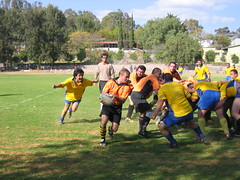
BY DAVID AGREN/THE HERALD MEXICO
El Universal
January 31, 2006
Shortly after founding the Guadalajara Rhinos Rugby Club, coach Eduardo Fernández used to organize weekly practices at an ill-equipped pitch in suburban Guadalajara only to have no one show up. Last Saturday, in a giant step forward for his squad and the sport´s stature in western Mexico, the Rhinos, scrummed down against the University of Celaya, Guanajuato, for the Mexican Rugby Federation´s top prize, the Raúl Monroy Cup, a mere three seasons after the Guadalajara team was formed.
"The work of the last three years is reflected in today´s final," Fernández said prior to kickoff. "Each season we´ve been improving."
Although not especially popular in Mexico, rugby is gradually inching towards a more prominent spot on the country´s sporting landscape. An estimated 650 players participate in the sport nationwide. Mexico joined the International Rugby Board in 2004 and sent a national team - known as the Serpientes - to a prestigious seven-aside tournament in Los Angeles for the first time last winter, placing 14th in the 16-team event and defeating the West Indies squad.
Outside of Mexico City, five new teams now compete in the Mexican Rugby Federation´s 12-team circuit, which stretches from Cordoba, Veracruz, in the east to Guadalajara in the west. For the first time in decades, a team from outside of Mexico City won the league championship, when Celaya captured last year´s title.
"One good thing that´s been happening in Mexican rugby is the growth we´ve had outside of Mexico City," explained Fernández, a quixotic figure who´s founded two clubs.
Fernández played for 16 seasons with the University of Guanajuato before founding cross-town rival Dragones five years ago. Upon moving to Guadalajara, he partnered with John Tobin, an Irish expatriate, to start the Rhinos.
The pair quickly found Enrique Estrada, who grew up playing rugby at the Greengates school in suburban Mexico City, to manage the club´s off-field matters, which besides renting pitches, rounding up sponsors and procuring a stand-by ambulance for each game, includes organizing the "tercer tiempo," a post-match social event, where the battered and bruised players put aside on-field differences and enjoy some good-natured camaraderie over tacos and beers.
Despite the recent growth, Mexican rugby lacks strong organization and funds for promotion. Players usually pay for all expenses, including the cost of renting fields, which are usually better suited to other sports and often missing uprights and locker rooms. Expatriates occupy up to half the roster spots on some squads as Mexico still develops relatively few players.
For some teams, just attracting enough players to each game presents an enormous challenge. Guadalajara advanced to the cup final after a Mexico City squad defaulted. The Rhinos used to field a sizable contingent of exchange students each season, leaving the team constantly scrambling to find new members .
But with a growing number of foreign players putting down roots in Guadalajara and increased Mexican participation in the sport, Estrada envisions the Rhinos becoming a contender in the near future; the club swept this season´s games against the two Guanajuato squads and qualified for last weekend´s cup final against Celaya. For the last road trip to Guanajuato, 19 players made the three-hour journey, a record turnout.
A RUGBY TOWN
Rugby has enjoyed more popularity in Guanajuato than any other city outside of the capital. The University of Guanajuato has fielded a rugby squad for more than 25 years. For most of that time it was the lone non-Mexico City team, a pioneer status the club´s longtime members embrace - even though on-field glory has been scant; the squad has only won one national championship.
"It´s been a source of pride for us," coach José Jesús Álvarez said of his club´s longevity. "We´ve been fortunate to have people who participate year after year."
Still, despite the club´s history, attracting players takes effort for Álvarez and his crew.
"It´s not that easy," he said. "Many people come out, but when they begin to see the discipline, the contact, everything involved, they don´t stay."
The university, however, produced enough players over the years that a new squad, the Guanajuato Dragones, was formed. Beyond the Bajio, University of Guanajuato alumni - like Eduardo Fernández - occupy spots on many Mexican club rosters, which Álvarez said made it difficult for his squad to build a winning tradition.
"They finish up here and then they leave for other teams," Álvarez said, explaining that students constitute almost the entire University of Guanajuato roster.
In contrast, the University of Celaya regularly fields a squad laden with experienced foreigners, who work in the eastern-Guanajuato city and nearby Querétaro, home to a number of multinational companies.
For last weekend´s title game, played on a wind-swept pitch in a Tlajomulco, Jalisco, industrial park, the Celaya players arrived on a comfortable charter bus and took the field wearing crisp white uniforms, emblazoned with sponsors´ logos, looking every bit the championship team.
Celaya trounced the Rhinos 81-17 in the Raúl Monroy Cup final, which capped a short tournament-style season. Guadalajara kept the game close in the first half, but the larger and more experienced Celaya players overpowered the Rhinos in the second half, effortlessly running up the score.
Celaya captain Gustavo Hernández, however, complimented the Guadalajara team.
"It´s only a question of one or two years before they reach the top level," he said.


No comments:
Post a Comment